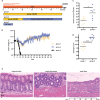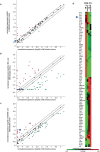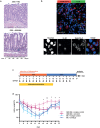The Anti-Hiv Candidate Abx464 Dampens Intestinal Inflammation by Triggering Il-22 Production in Activated Macrophages
- PMID: 28687795
- PMCID: PMC5501810
- DOI: 10.1038/s41598-017-04071-3
The Anti-Hiv Candidate Abx464 Dampens Intestinal Inflammation by Triggering Il-22 Production in Activated Macrophages
Abstract
The progression of human immunodeficiency virus (HIV) is associated with mucosal damage in the gastrointestinal (GI) tract. This damage enables bacterial translocation from the gut and leads to subsequent inflammation. Dextran sulfate sodium (DSS-exposure) is an established animal model for experimental colitis that was recently shown to recapitulate the link between GI-tract damage and pathogenic features of SIV infection. The current study tested the protective properties of ABX464, a first-in-class anti-HIV drug candidate currently in phase II clinical trials. ABX464 treatment strongly attenuated DSS-induced colitis in mice and produced a long-term protection against prolonged DSS-exposure after drug cessation. Consistently, ABX464 reduced the colonic production of the inflammatory cytokines IL-6 and TNFα as well as that of the chemoattractant MCP-1. However, RNA profiling analysis revealed the capacity of ABX464 to induce the expression of IL-22, a cytokine involved in colitis tissue repair, both in DSS-treated mice and in LPS-stimulated bone marrow-derived macrophages. Importantly, anti-IL-22 antibodies significantly reduced the protective effect of ABX464 on colitis in DSS-treated mice. Because reduced IL-22 production in the gut mucosa is an established factor of HIV and DSS-induced immunopathogenesis, our data suggest that the anti-inflammatory properties of ABX464 warrant exploration in both HIV and inflammatory ulcerative colitis (UC) disease.
Conflict of interest statement
D.S., A.G., N.C. and H.J.E. are Abivax employees and hold Abivax stock options. J.T. is a member of the ABIVAX scientific advisory board and the collaborative laboratory that has received financial support from Abivax.
Figures






References
-
- Scherrer, D. et al. Pharmacokinetics and tolerability of ABX464, a novel first in class compound to treat HIV infection, in healthy HIV- uninfected subjects. Journal of Antimicrobial Chemotherapy72, 820–828 (2017). - PubMed
Publication types
MeSH terms
Substances
LinkOut - more resources
Full Text Sources
Other Literature Sources
Medical
Molecular Biology Databases
Miscellaneous

